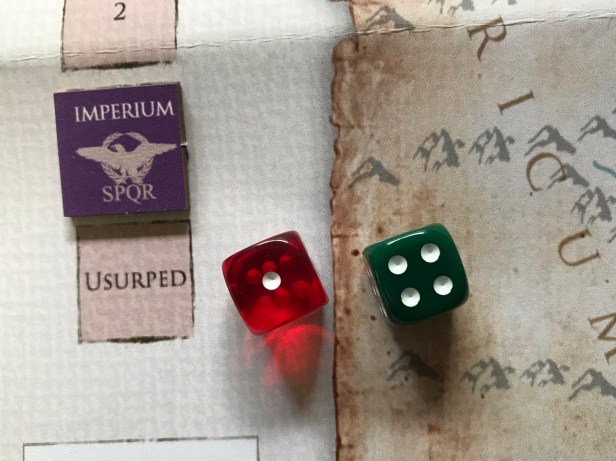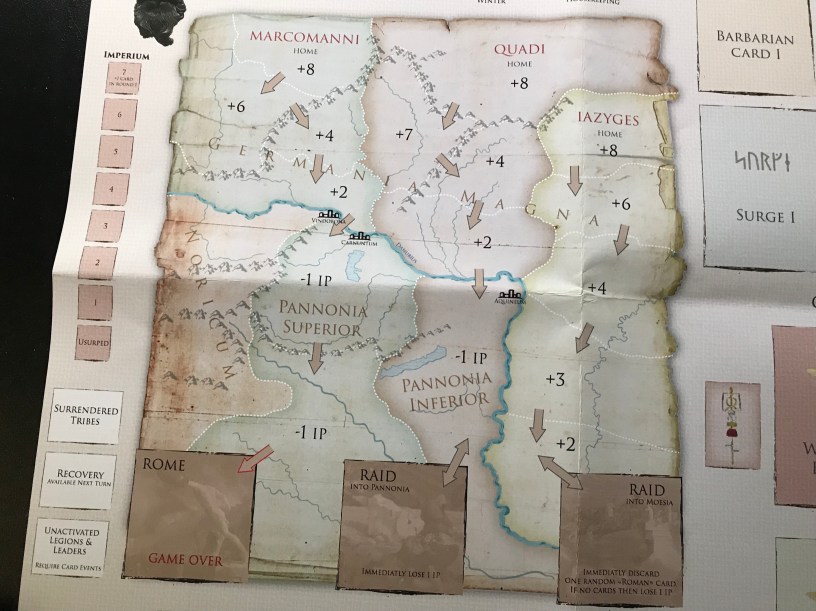I recently found this little solitaire wargame called The Wars of Marcus Aurelius: Rome 170-180CE from Hollandspiele and really have enjoyed the game as I have played it 8 times in the last few weeks. That’s the good news. The bad? I have only won the game once….and even though that is the case, I can’t stop thinking about the game and playing it. It is really good!
The Wars of Marcus Aurelius: Rome 170-180CE is a solitaire only game that uses cards similarly to a CDG to simulate the strategic level struggle of the Romans led by Marcus Aurelius to stave off the invasions of Germanic tribes and Sarmatian raiders as they encroach on Roman territory across the Danube River.
That’s the history. And it is really well integrated. The game play is very fun, strategic, with lots of decision points about what to do and what cards to use, and it is really challenging. In this series of Action Points we will take a dive into some of the elements, including the map, the cards and the gameplay and will also take a really good look at some of the strategies.
In this Action Point, we will examine the map and how the game uses the barbarian Tracks to simulate raids against the empire and other areas you must be focused on including the Imperium Track (don’t ignore or you will lose a lot!) and the Off-Map Conflict Boxes.
The Map
The map is a representation of the Imperial Roman frontier around 170CE in northeastern Europe and uses the Danube River as it’s main boundary between the Romans and their enemies the Germanic tribes in the Marcomanni and Quadi and Sarmatian invaders the Iazyges. The map is divided into three main sections that I will call “tracks”, which provide a path for the invaders to travel down attempting to cross the Danube and cause trouble for the Romans.

In the spaces on these Tracks north of the Danube are numbers such as +2, +4, +6 and so on. These numbers represent terrain in the area and provide a combat bonus to the strength of the barbarian defenders. Think of this as the terrain is not conducive to large matching armies with thick forests, wetlands and poor roads and allow for the barbarians to nullify the numerical advantage of the Romans with ambushes and attacks in passes to nullify numerical advantage. As you move up the Track pushing the barbarians closer to their home space where you can pacify them and force their surrender they are going to stiffen and it will be more and more difficult to beat them.

You will also notice the numbers south of the Danube do not have + numbers but show a -1 IP value. If the barbarians ever move into these spaces the player will lose an Imperium Point or IP at the end of the round. This makes the Roman people nervous and they begin to clamor against Marcus Aurelius as the barbarians near their doorstep.

Finally, at the end of each of the three Tracks are located what are called boxes and each has a different effect. If the barbarians enter the “Raid Into Moesia” box, the player will have to immediately discard a random Roman card from their hand. If the player has no cards, they will have to lose 1 IP. If barbarians enter the “Raid Into Pannonia” Box, the player will lose 1 IP and finally if a barbarian ever enters the “Rome” box, the game immediately ends.

Players will find themselves prioritizing these Tracks and boxes to mitigate their effects. Players typically will focus on the Marcomanni Track first and then the Iazyges next, as both of these can cause you to quickly lose. While there is no auto loss condition for the Iazyges Track, losing cards is very bad as you are probably going to be stockpiling cards to maximize your actions in the upcoming round or to increase the power of your attacks but more on this in Action Point 2.
Players will spend their time planning attacks against one or more tribes and will most likely have to focus on one Track at a time to be effective. With that being said, you really will have to manage all Tracks simultaneously as you don’t want them to get out of hand as you will have scarce resources, with not enough armies or good leaders, and as the year progresses you will also get fewer and fewer cards to take actions with.
Each of these Tracks have an Army Box with a Leader Box located on the bottom which will hold the Legions and Leader that you have assigned to this Track for the year.
Imperium Track

Imperium Points are a way to measure the authority of Marcus Aurelius and the confidence in him of the people of Rome. This Track can go up or down with events from cards or down due to poor battles (bad dice rolls with an army led by Marcus Aurelius). When you lose an IP, players will move the marker down and when they gain an IP it will move up. But you must pay attention to this Track as if the marker ever reaches the bottom space, Marcus Aurelius is considered to have been usurped and the player will automatically lose.

This Track is one of the best elements of the design and will lead to about 75% of all losses by players if they don’t pay attention and give it some focus. I tell myself that I have to take care of my IP first before I can hope to defeat the invaders in combat and I like this as it really represents the support and control of the leadership of Marcus Aurelius.
Off-Map Conflict Boxes
There is a small part of the game that can cause some major pain if you don’t control it and that is the Off-Map Conflict Boxes located on the right side of the map board. These boxes represent goings on in the Eastern Empire and the Western Empire and if one of the Off-Map Conflict cards is drawn they will be placed in the corresponding box to be dealt with by the player in due time. But don’t wait too long as there are negative effects as they persist and they will begin to undermine the authority of Marcus Aurelius and will ultimately cause the loss of IP and can lead to usurpation!

These cards represent civil wars, invasions and mutinies and provide another threat to the player to deal with. I have found that you will typically draw them later in the round without the appropriate amount of time to deal with them causing them to linger and cause you to lose IP’s. The cards are a great vehicle though to bring the history to life and to offer some diversity to the game and add a different type of challenge.

I hope you can get a feel for the situation that The Wars of Marcus Aurelius: Rome 170-180CE is designed around and can see how you will be challenged as you attempt to quell the invaders. In Action Point 2, you will see that situation heat up as I explain the cards, and take a look at the Barbarian Deck.
-Grant

Nice summary. I just got this and look forward to getting it on the table. Hollandspiele’s production values are very nice, I have to say. Those heavy chits are great.
LikeLiked by 1 person
This game is a gem, and I love that you’re giving it visibility with this review! I played the heck out of this title when I first got it. Makes me want to dig it out and give it another go!!
LikeLiked by 1 person